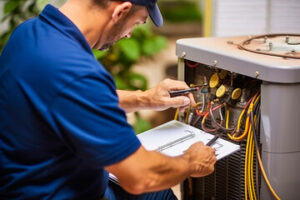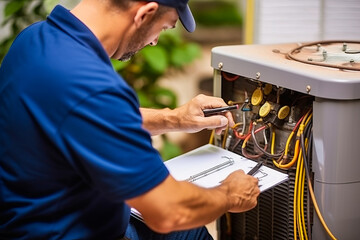Keeping HVAC Round Rock system properly maintained helps it function efficiently and provide optimal comfort for years to come. Regular tasks and professional inspections help identify issues early and reduce repair costs.
Customized components like ductwork and zoning systems ensure air distribution is optimized for a home’s unique layout and occupancy patterns. This can help reduce hot and cold spots and prevent energy waste in unused rooms.
When the temperatures plunge in the winter, heat pumps are a cost-effective and climate-friendly solution. Unlike traditional furnaces and air conditioners, which burn fuel to generate their own heat, heat pumps absorb and move ambient heat into the home. This allows them to be upwards of 400% efficient. To do this, they use a reversing valve that allows the volatile fluid (refrigerant) in their piping to go back and forth between absorbing heat and rejecting it.
Heat pumps are easy to recognize based on their outdoor unit, which looks like an air conditioner with several essential components added: a fan, compressor, and coils. The indoor unit, known as an air handler, also has a coil and fan to distribute conditioned air. It also has a reversing valve that switches between cooling and heating modes.
In cooling mode, the reversing valve opens the compressor and the coils to evaporate the refrigerant and soak up heat from the air in your home. Then, the blower moves the cooled refrigerant through your home’s ductwork and throughout its rooms.
The reversing valve closes when the thermostat calls for heating. The evaporator coil and the backup electric coils are activated. This heats up your home’s ductwork and distributes the heated air throughout the house via the fan.
When the reversing valve opens and the compressor evaporates the refrigerant again, it absorbs heat from the outside air in a process similar to that of an air conditioner. This heat is then transferred to the evaporator coil, which absorbs it for heating. The process is repeated, and the reversing valve closes when the temperature dips below freezing. Heat pumps are more expensive to purchase than air conditioning systems, but their lower operational costs can save homeowners money over time. They can also help cushion home owners against rising natural gas prices and climate disasters by reducing dependence on fossil fuels. Choosing to build all-electric homes with heat pumps can also mitigate carbon emissions, especially in states that still rely on coal for electricity generation.
Air Conditioners
Air conditioning is a key part of the HVAC system that focuses on cooling the air inside your home to maximize comfort and livability. To do this, it uses a refrigerant that cycles between liquid and gas states, absorbing heat energy from the air and pumping cool air back into your house.
The way it works is this: Air conditioners have an indoor unit that houses evaporator coils and a fan to blow air over the coils. As air passes over the evaporator coils, it absorbs heat energy because the evaporator coils are cold. The refrigerant then changes phase from a cold liquid to a hot vapor and goes through the compressor. The compressor compresses the refrigerant, which increases its temperature and pressure, enabling it to remove more heat from the home’s air. After the heat is removed from the home’s air, the refrigerant releases its heat into the outdoor air by passing through a condenser coil. The refrigerant then returns to the evaporator coils, where it repeats the cycle of heating and cooling the room.
There are two main types of air conditioning systems: ductless and central. Ductless systems, also known as split wall-mounted air conditioners, contain an outdoor unit and an indoor unit that are connected by copper tubing. They are more common in newer homes because they are more energy efficient than traditional whole-house AC units.
A central air conditioner is the largest and most conventional type of AC. It has two units—a boxy outdoor unit that contains the compressor and a condenser coil, as well as an indoor unit that has an evaporator coil and fan. The two units are connected by refrigerant tubing.
When a central air conditioner is operating, its thermostat senses that the indoor air temperature has risen above your preferred setting. The thermostat then signals the air conditioner to begin the process of cooling the room. A compressor then moves liquid refrigerant into an indoor evaporator coil, where it evaporates and pulls heat energy from the room’s air. The cooled air then circulates through the ductwork to other rooms in your home.
Furnace
Your home’s furnace is an essential part of the heating and cooling system that makes your house comfortable throughout the year. Its main job is to convert cold air into warm air and distribute it through a network of ductwork. It is powered by a variety of energy sources including natural gas, oil, and electricity. The components of a furnace include a thermostat, gas valve, burners, heat exchanger, blower motor, and air ducts. If you notice problems with your furnace, such as frequent shutdowns or strange smells or the pilot light is flickering, it’s time to call a professional technician.
When the thermostat signals your furnace to turn on, it activates a gas valve that supplies fuel to the burners. Then, the gas ignites and heats up the exchanger in the furnace to warm the air. This process continues until the desired temperature setting on your thermostat is reached. Once the desired temperature is achieved, the system turns off and the gas valve closes.
After a short delay to allow the heat exchanger to cool, the blower motor starts working to push warmed air through the supply and return ducts into living spaces. A filter can be installed to prevent dirt and dust from being blown into living areas. Depending on your home’s needs, you can choose between a single stage or two-stage gas furnace. Two-stage systems offer a low and high heat setting. They can be a great option in Northern California where temperatures can fluctuate and electricity costs are high.
The EPA recommends a minimum efficiency rating for furnaces, known as a MERV rating. A MERV rating of between 7 and 10 indicates that the furnace meets the EPA’s minimum standard for indoor air quality. A higher MERV rating typically means lower energy bills and a more environmentally responsible heating system. You can also choose an ENERGY STAR qualified gas furnace to receive additional savings on your utility bills. These units meet stringent emissions and efficiency standards. However, the upfront cost of this type of unit may be a bit more expensive than other models.
Ductwork
The term “ductwork” refers to the network of pipes and channels that deliver heated or cooled air from your HVAC equipment to your home’s various rooms. The system also transports expended air back to your HVAC equipment for reconditioning. A poorly functioning ductwork can cause uneven temperatures, poor indoor air quality, and higher energy costs.
Usually located in the attic or crawl space, your ducts are typically hidden from view. They may be made of fiberglass, sheet metal, or other flexible materials like plastic. Ducts can be configured to accommodate various sizes of spaces and can include specialized components such as dampers, plenums, duct fittings, and takeoffs.
When a heating or cooling system operates, the blower fan creates static pressure, which pushes air through the ductwork. If the system isn’t properly sized, this static pressure can cause the blower fan to work much harder than it should, shortening its lifespan and increasing your energy costs.
As your air travels through a ductwork system, it’s filtered and warmed or cooled by the HVAC equipment before reaching each room. The supply ducts deliver the conditioned air to your living areas, and they’re equipped with dampers that can be adjusted to regulate the flow of air to certain sections of your house. Depending on the type of ducting you have, the return ducts might also be equipped with dampers that can be set to control the airflow to your HVAC equipment.
Aside from its primary function of delivering conditioned air, a well-designed ductwork system is vital to your home’s comfort. It should be adequately sized to match your HVAC equipment, insulated for energy efficiency, and free of leaks.
A reputable HVAC contractor will use an industry standard formula known as Manual D to determine the ideal size for your home’s ductwork, and they’ll ensure that your ducts are properly fabricated and insulated. A faulty or improperly designed ductwork system can damage your HVAC equipment, increase your energy costs, and create a hazardous environment by causing excessive noise and creating insufficient airflow.
